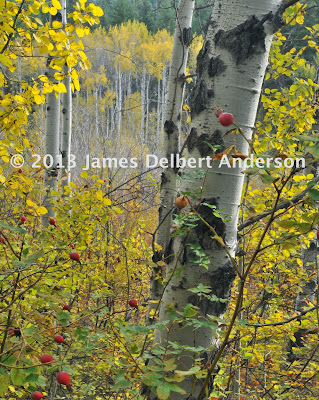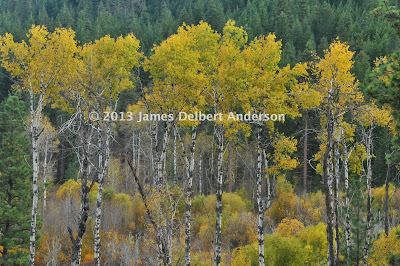I'm sure you've all visited places of which you've seen pictures or heard wonderful stories, and then found disappointing. There's nothing wrong with them, but they're a bit underwhelming when experienced. The views aren't what they're cracked up to be, or they're just views of clearcut hills; the "old-growth" forest isn't really all that old; the fall color just looks mottled and depressing; the "creek" is a trickle; or any other such scenario. All of these have happened to me.
But last weekend, which I spent in the Methow River Valley, was not one of those times. The fall colors and vistas of the Methow River lived up to the pictures and the stories. It was a whirlwind weekend: I woke up at 4am on Saturday, drove to the campsite, set up cams, and struck off with my camera. I was only able to photograph that evening and Sunday morning; by Sunday afternoon, I had to be on my way home. (I'd had three days free the previous weekend, but it rained every day, of course. I decided I'd rather camp for an overnight in dry conditions than do a longer trip in the rain. I've been camping in the rain all summer, and enough is enough).
Pearrygin Lake
We'll start our journey at Pearrygin Lake State Park. It actually wasn't my first choice for camping; there were some campgrounds on national forest land that seemed more interesting, but the federal shutdown threw a wrench in these plans. Unless you're into launching boats and such, I don't know if I'd necessarily recommend camping at Pearrygin. The campsites are not private at all, and I imagine the place is swarming with RVs during the summer. Nevertheless, on an off-season weekend in one of the lakeside campsites in the East Campground (don't camp in the West Campground unless you enjoy being deafened by boats), you can still have a peaceful camping experience.
Below is the view from a couple campsites over from mine. I used an aperture of f/22 to keep as much as possible in focus, but I cranked the ISO up to 400 to get a shutter speed of 1/10 sec - that created the specific look in the ripples that I wanted to achieve. Any longer and they would have been indistinct; any shorter and they wouldn't have looked smooth enough.
Beaver Pond
Saturday evening, I hiked the Beaver Pond trail and the Sunnyside trail, making them into a kind of loop. The Beaver Pond trail is interesting, as it travels through a moist bottomland and thus a lush forest of aspen, pine, and various shrubs and bushes. The first image encapsulates the nature of this trail, featuring a young ponderosa pine in the foreground, an aspen trunk, and a view across the wetlands to more aspen. True to form, I used a narrow aperture - f/32 in this case - and an in-between focus point to keep everything in focus. I don't think this picture would have been as interesting if the trees in the background had been obscured.
The second images puts ponderosa branches in the foreground, with aspen in the background. In a way, it is similar in concept to the image above, but different in approach. I used f/11 as a compromise - I wanted to isolate the branch in the foreground, but not so much that the trunks and leaves in the background were completely obscured. I tried a variety of camera heights on this one; I've said that your camera's elevation should be just as intentionally chosen as the spot from which you're photographing, and it was really true in this case.
Next are aspen trunks and leaves of other forest plants in various stages of fall color. I struggled a bit to find a good vantage point that would include these elements and not too much forest-floor detritus. Even this is cropped to 8x10; at the original aspect ratio, there was an unattractive area of dead stuff on the right. I used f/22 to get a wide depth of field.
The image below was almost impossible to capture, and I wasn't able to do it exactly the way I'd have wanted. What you see was taken with an aperture of f/22. I liked f/29 better compositionally, because the aspen trunks in the background showed up more clearly. But even at ISO 400, that required a shutter speed too long for the breeze at the time (and above ISO 400 quality seems to degrade).
Now, a view of the Beaver Pond itself. I thought that including the mountain, but not all of it, would add a little contrast to the muted yellows, browns, and greens. Aperture? F/25. As usual, I wanted to keep as much in focus as possible.
Next is another view across the beaver pond. Lately, I've tended to avoid using dead things such as snags, stumps, dead plants, and others for a subject. I find living matter more interesting to photograph on the whole. In this case, though, I thought the dead branches made an interesting shape, and created some striking contrast.
The most difficult aspect of the next image was choosing a focus point. Even at f/32, I couldn't get everything into perfect focus - I had to sacrifice a bit of sharpness in either the background or the rose hips in the foreground. The image I've posted is the one that preserves sharpness in the rose hips and loses a bit in the background - I decided the image would make the most sense if the foreground were all as sharp as possible.
They're watching you! The whiteness of the aspen trunks, along with the eye-like places where branches used to be (I'm assuming), are the features of this image. I used f/25 to keep everything in focus. I actually think that a wider aperture wouldn't have necessarily hurt the image, but I still like having a wide depth of field and a clear context for the trunks.
Sunnyside
To hike the Sunnyside trail is to travel through a different world. If you are heading east, from its junction with the Beaver Pond trail, you'll start in a mixed forest but climb into a purer ponderosa pine forest and then, eventually, a more open and grassy environment. On this better-drained, south-facing slope, only a scattering of pine and aspen grow. It's different, but still lovely, and the views across the basin are still very nice. The one image that turned out well from that trail is one such view.
Methow River
Finally, I hiked a portion of the Methow Valley Community Trail on Sunday morning, which follows its eponymous river with frequent views of it. Like the Beaver Pond area, this is a bit of an ecological world apart. There are plenty of the ubiquitous ponderosa pine, to be sure, but there are lots of cottonwood and deciduous bushes. There are a few (relatively) lush grassy meadows, some aspen groves, and - if you look carefully - a few guests more commonly seen on the west side: red alder and western red cedar!
I got a late start, because I had expected the previous evening that clouds would be moving in...but they didn't. Not really, anyway. So I was stuck with less-than-ideal sunny mid-morning conditions.
Below is my favorite image, setting cottonwoods against a ridge across the valley. Contrast the steep, dry, sparsely vegetated hillside with the deciduous trees on the valley bottom. What a difference geography makes! Although it was already getting rather late, the side lighting helps bring out the contours of the hill and make the image interesting (front lighting would have flattened it all out). I used f/18 to keep everything in focus; I didn't need to go any narrower because all the subject matter was fairly far away.
Now we see the Methow River itself. I used f/32 to get a longer shutter speed to blur the water a bit. I liked the way angled sunlight was hitting the cottonwood in the foreground.
Fall color extravaganza! This image comes from a swampy area along the trail. Again, the sun was a lot higher than I would have preferred for shooting a scene like this, but the side lighting helps a bit. I like how the areas of color are pretty clearly delineated; blue, yellow-and-green, red.













No comments:
Post a Comment